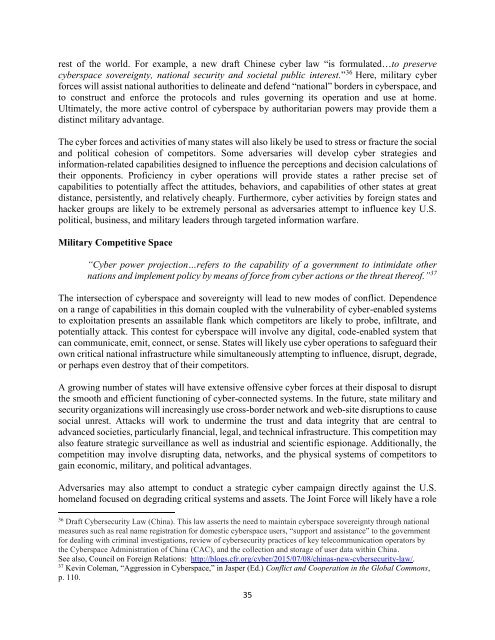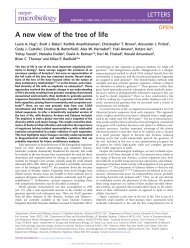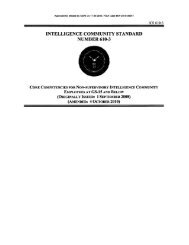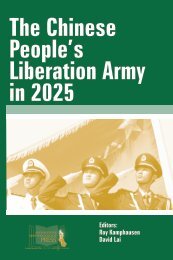The Joint Force in a Contested and Disordered World
JCS-JOE-2035
JCS-JOE-2035
Create successful ePaper yourself
Turn your PDF publications into a flip-book with our unique Google optimized e-Paper software.
est of the world. For example, a new draft Ch<strong>in</strong>ese cyber law “is formulated…to preserve<br />
cyberspace sovereignty, national security <strong>and</strong> societal public <strong>in</strong>terest.” 36 Here, military cyber<br />
forces will assist national authorities to del<strong>in</strong>eate <strong>and</strong> defend “national” borders <strong>in</strong> cyberspace, <strong>and</strong><br />
to construct <strong>and</strong> enforce the protocols <strong>and</strong> rules govern<strong>in</strong>g its operation <strong>and</strong> use at home.<br />
Ultimately, the more active control of cyberspace by authoritarian powers may provide them a<br />
dist<strong>in</strong>ct military advantage.<br />
<strong>The</strong> cyber forces <strong>and</strong> activities of many states will also likely be used to stress or fracture the social<br />
<strong>and</strong> political cohesion of competitors. Some adversaries will develop cyber strategies <strong>and</strong><br />
<strong>in</strong>formation-related capabilities designed to <strong>in</strong>fluence the perceptions <strong>and</strong> decision calculations of<br />
their opponents. Proficiency <strong>in</strong> cyber operations will provide states a rather precise set of<br />
capabilities to potentially affect the attitudes, behaviors, <strong>and</strong> capabilities of other states at great<br />
distance, persistently, <strong>and</strong> relatively cheaply. Furthermore, cyber activities by foreign states <strong>and</strong><br />
hacker groups are likely to be extremely personal as adversaries attempt to <strong>in</strong>fluence key U.S.<br />
political, bus<strong>in</strong>ess, <strong>and</strong> military leaders through targeted <strong>in</strong>formation warfare.<br />
Military Competitive Space<br />
“Cyber power projection…refers to the capability of a government to <strong>in</strong>timidate other<br />
nations <strong>and</strong> implement policy by means of force from cyber actions or the threat thereof.” 37<br />
<strong>The</strong> <strong>in</strong>tersection of cyberspace <strong>and</strong> sovereignty will lead to new modes of conflict. Dependence<br />
on a range of capabilities <strong>in</strong> this doma<strong>in</strong> coupled with the vulnerability of cyber-enabled systems<br />
to exploitation presents an assailable flank which competitors are likely to probe, <strong>in</strong>filtrate, <strong>and</strong><br />
potentially attack. This contest for cyberspace will <strong>in</strong>volve any digital, code-enabled system that<br />
can communicate, emit, connect, or sense. States will likely use cyber operations to safeguard their<br />
own critical national <strong>in</strong>frastructure while simultaneously attempt<strong>in</strong>g to <strong>in</strong>fluence, disrupt, degrade,<br />
or perhaps even destroy that of their competitors.<br />
A grow<strong>in</strong>g number of states will have extensive offensive cyber forces at their disposal to disrupt<br />
the smooth <strong>and</strong> efficient function<strong>in</strong>g of cyber-connected systems. In the future, state military <strong>and</strong><br />
security organizations will <strong>in</strong>creas<strong>in</strong>gly use cross-border network <strong>and</strong> web-site disruptions to cause<br />
social unrest. Attacks will work to underm<strong>in</strong>e the trust <strong>and</strong> data <strong>in</strong>tegrity that are central to<br />
advanced societies, particularly f<strong>in</strong>ancial, legal, <strong>and</strong> technical <strong>in</strong>frastructure. This competition may<br />
also feature strategic surveillance as well as <strong>in</strong>dustrial <strong>and</strong> scientific espionage. Additionally, the<br />
competition may <strong>in</strong>volve disrupt<strong>in</strong>g data, networks, <strong>and</strong> the physical systems of competitors to<br />
ga<strong>in</strong> economic, military, <strong>and</strong> political advantages.<br />
Adversaries may also attempt to conduct a strategic cyber campaign directly aga<strong>in</strong>st the U.S.<br />
homel<strong>and</strong> focused on degrad<strong>in</strong>g critical systems <strong>and</strong> assets. <strong>The</strong> <strong>Jo<strong>in</strong>t</strong> <strong>Force</strong> will likely have a role<br />
36<br />
Draft Cybersecurity Law (Ch<strong>in</strong>a). This law asserts the need to ma<strong>in</strong>ta<strong>in</strong> cyberspace sovereignty through national<br />
measures such as real name registration for domestic cyberspace users, “support <strong>and</strong> assistance” to the government<br />
for deal<strong>in</strong>g with crim<strong>in</strong>al <strong>in</strong>vestigations, review of cybersecurity practices of key telecommunication operators by<br />
the Cyberspace Adm<strong>in</strong>istration of Ch<strong>in</strong>a (CAC), <strong>and</strong> the collection <strong>and</strong> storage of user data with<strong>in</strong> Ch<strong>in</strong>a.<br />
See also, Council on Foreign Relations: http://blogs.cfr.org/cyber/2015/07/08/ch<strong>in</strong>as-new-cybersecurity-law/.<br />
37<br />
Kev<strong>in</strong> Coleman, “Aggression <strong>in</strong> Cyberspace,” <strong>in</strong> Jasper (Ed.) Conflict <strong>and</strong> Cooperation <strong>in</strong> the Global Commons,<br />
p. 110.<br />
35











